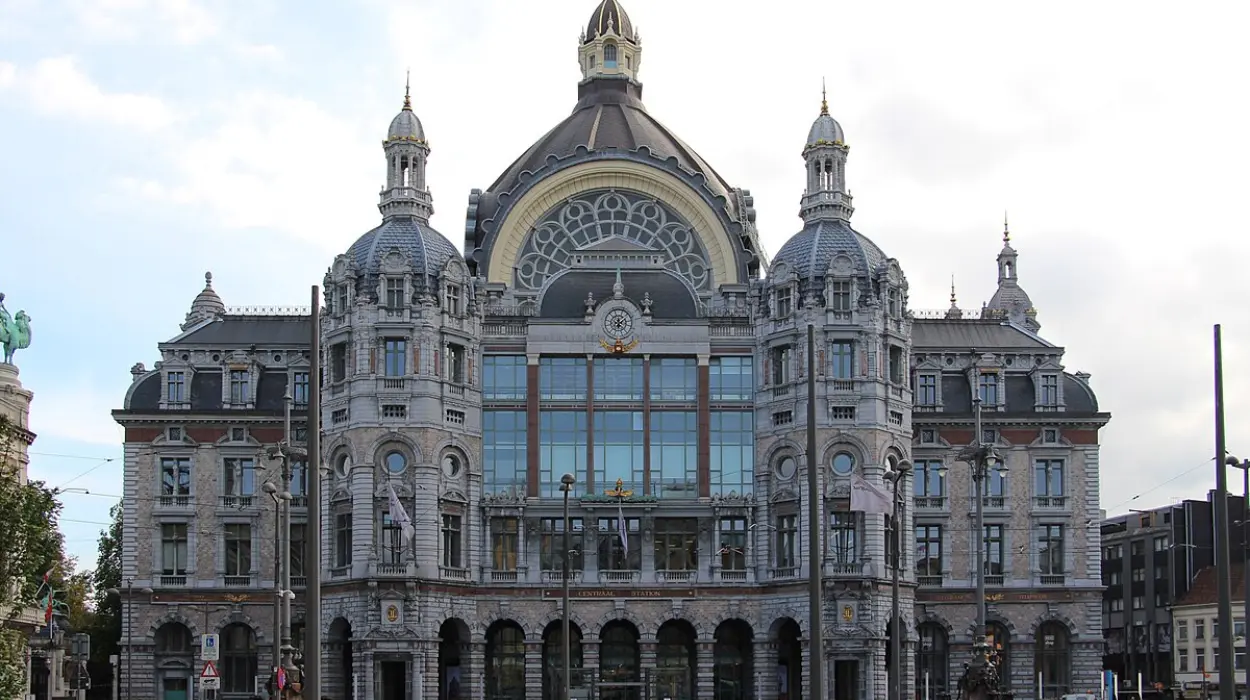“ Life is a train….get on board !”
Khaled Hosseini: Afghan/ American novelist
It is no surprise to any European traveler that train travel can be one of the most comfortable, convenient, and affordable modes of travel. You cannot beat the Eurostar 1-hour Brussels to Paris run, for example. For tourists, the Eurail pass has long been the preferred method for visiting the great European cities while viewing the countryside at ground level. But have you ever considered the cultural value of the train stations themselves? This article directs your attention to some of the hidden histories.
No discussion of Belgium’s train stations would be credible without mentioning Antwerp’s train Station the Railroad Cathedral. The massive stone structure looms large in Antwerp’s historic city center. It was designed by one of Belgium’s most prolific architects— Louis Delacenserie. Construction began in 1895 with the full backing of King Leopold I.
The cathedral—rather the train station —was inspired by the classic designs of the Italian Renaissance but borrowed from what is known as the Belgian Gothic Revival Movement. Byzantine and Moorish architectural designs influences are evidenced in the station arches and complex tile designs.
The detailed exterior walls are made of twenty kinds of marble and stone topped off with a massive copper dome (75 metres in height!), supported by Moorish columns—all of which are surrounded by four levels of stained-glass windows. Dominating the interior is a massive signature clock resting on a shelf that depicts Antwerp’s coat of arms. You would be hard pressed to find a more eclectic, yet symmetrical, blend of architectural details in any Belgian structure from this period.
The Liège-Guillemins station could not be any more different than Antwerp’s Railroad Cathedral. The futurist design was concepualised by the Swiss/Spanish architect Santiago Calatrava whose resume includes: The World Trade Center Transportation Hub (New York), Valencia’s City of Arts and Sciences, The Olympic Sports Center (Athens) and the iconic Alamillo Bridge in Seville, Spain.
The station is a 21st Century architectural style that has come to be known as Neo-Futuristic. It emphasizes the use of steel, white concrete, and massive applications of glass, which collectively eliminate the distinction between outdoors and indoors. The glass, lace-like roof stretches 160 metres, 32 metres high, and covers the high-speed train tracks and platforms. Calatrava’s creations resemble living organisms and the Liège station is said to resemble a “praying mantis.”
The creation’s grand opening (2009) by Franco Dragone—the theater director famous for his large-scale production of Cirque du Solei . The grand opening featured a show of 300 actors, 1500 rockets, a giant 32m screen , light shows, and music by Liège’s Philharmonic Opera.
The train station in Bruges—Gare de Bruges—is neither grand or spectacular but its legacy is uniquely humorous. The original Ghent to Brussels line originated here in 1879 and was followed by the Bruges to Ostend line. The result of such rapid growth resulted in an austere station that was functionally too small. Reconstruction started in 1879 at its present site. After completion, it became apparent that the building had been rebuilt backwards in that the building faced the tracks instead of the street! It took 8 years to demo and rebuild the new station. Today the modernized station correctly faces the street (sarcasm) and is the 10th busiest in Belgium.
If ever there was a Belgian family of polymaths, it would be the Cluysenaar family. Notables include accomplished: engineers, painters, sculptors, financial bankers, poets, real estate moguls, and politicians. The most famous was architect Jean-Pierre Cluysenaar (1811-1880). He studied at the Brussels Royal Academy of Arts, and although he showed a preference for Italian Renaissance designs, he always adapted his works to the desires of his elite patrons—often Brussel’s nobility.
Jean-Pierre also had the added talent of real estate and financial savvy. He designed and financed the Royal Saint-Hubert Galleries in Brussels, the DeViron Castle in Dilbeek (Flemish Brabant) , the concert hall in Aachen, the bandstand in Brussels Park, the Bortier Gallery in Brussels (the first of its kind) and the Royal Conservatory of Brussels. In 1856 Jean-Pierre along with King Leopold I inaugurated the railway station in Aalst, east Flanders.
Art historians have noted the unique mixture of a medieval castle and the classic gothic style, Tudorgotic replete with pointed arches, prominent turrets, bay windows, and cross-story grill work. The station was built with Boomse baksteen brick (unique to Belgium) and blue stone pavers. Jean-Pierre built many stations in Belgium, but the Aalst train station is the only one that exists today.
There are plenty of reasons to consider train travel. Usually train stations are at the center of their cities. There are no airport transfers, no baggage fees, stable time tables, and simple boarding procedures. Consider too that most rail passes allow you to break-up your journey, allowing you to explore small towns and city centers. Taking the time to consider the story of the rail station itself can be a reason enough too. Safe Travels!
Dear reader,
Opinions expressed in the op-ed section are solely those of the individual author and do not represent the official stance of our newspaper. We believe in providing a platform for a wide range of voices and perspectives, even those that may challenge or differ from our own. We remain committed to providing our readers with high-quality, fair, and balanced journalism. Thank you for your continued support.



